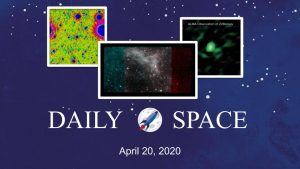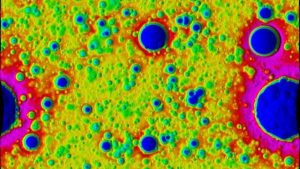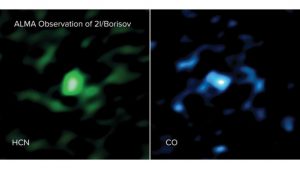
The first flight of NASA astronauts from U.S. soil in nearly nine years finally has a launch date: May 27. The impact of small bodies hitting an asteroid pulverizes its surface, making new regolith, while seismic shaking produced by the impact causes older regolith to move downhill and fill already existing craters. Studies of a comet from beyond our Solar System have yielded insights into how other star systems may have formed, and the California Nebula is the final mosaic image taken by Spitzer.
Links
May 27th mission will launch astronauts Bob Behnken and Doug Hurley to the International Space Station on a SpaceX Crew Dragon spacecraft
- SpaceX, NASA target May 27 for 1st Crew Dragon test flight with astronauts (Space.com)
- Bridenstine says Crew Dragon could launch with astronauts at end of May (Spaceflight Now)
- SpaceX’s Crew Dragon gets a launch date—May 27 (Ars Technica)
Impact cratering both produces new regolith and causes seismic events that can degrade and erase small craters on the surface of asteroids
- Impacts on Asteroids Produce Regolith, Erase Small Craters (Planetary Science Institute)
Studies of a comet from beyond our Solar System have yielded insights into how other star systems may have formed
- Hubble Observations Show Interstellar Comet 2I/Borisov Rich In Carbon Monoxide (Planetary Science Institute)
The California Nebula is the final mosaic image taken by Spitzer
Transcript
This is the Daily Space for today, Monday, April 20, 2020.
Welcome to the Daily Space, I am your host, Dr Pamela Gay, and I am here to put science in your brain. Most Mondays through Fridays either I or my co-host Annie Wilson will be here, bringing you a quick run down of all that is new in space and astronomy.

Welcome to Monday! The timing of our show means we sometimes miss breaking news in the moment that it is happening, and we want to start today’s episode with a story you may have already heard: On Friday, NASA Administrator Jim Bridenstein announced that NASA will be launching astronauts to the ISS aboard a SpaceX Crew Dragon on May 27. With the current pandemic, this means there is zero chance any of us here at CosmoQuest will be there to bring this to you live, but we will be following along at a safe distance. To use Bridenstine’s oft used phrase, NASA will one again launch American astronauts from American rockets from American soil.” Or, as we like to think of it – Oh – cool, a new rocket will launch from a launch site we can drive to! As always, space is everyone’s and Musk is a South African, who like many foreign born people throughout the aerospace agency, has come to live in the US because this is a good place to build and launch rockets. Go little rocket, go.

In other news, coming to you from right here at PSI, scientists have discovered that the same effects that weather the moon also affect objects as small as the asteroid 433 Eros. In a new paper appearing in the journal Icarus, a team lead by James Richardson has found that the steady impact of small objects onto Eros have a way of erasing other craters over time. This happens in two ways. Easiest to understand is the way small impacts simply batter down the surface, crumbling rocks to regolith and eroding sharp edged craters like rain on an unbaked adobe wall. Additionally, these impacts cause seismic tremors, and like tapping on the edge of a cup filled with flour will level the flour, tapping on an asteroid will level the regolith. This packs a one 2 punch that both effects the things being collided with and distant features that are simply getting shaken, and not stirred.

Objects colliding a breaking apart is apparently the way of things in our Solar System. From Eros’s impacts we now switch gears to look at the crumbling comet 2I/Borisov. As it passes near our Sun, this interstellar invader has been forming a tail and coma of material that is released as volatiles – all those ices rearing to become gas – sublimate away. On December 15-16, when Borisov was still one object, astronomers used the Atacama Large Millimeter Array to look at the chemical composition of Borisov. These results are now available in the journal Nature, and they show an unusually large amount of carbon monoxide gas and normal amounts of Hydrogen Cyanide. This implies that this comet, which originated in another solar system, must have formed someplace significantly colder than where our solar system’s comets come from.
While it’s not possible to speculate too scientifically about the origins of Borisov, this kind of a composition is consistent with Borisov coming from a solar system with an extremely extended disk, such as those currently being found by ALMA around low mass stars not too different from our sun. Until we find more interstellar comets, we can’t know what is more typical of the universe, comets like those produced in our Solar System, or high CO comets like Borisov. For now, we are going to enjoy Borisov’s shattered departure, and keep looking for more icy alien visitors.

In our final story, we just have a pretty picture. At the beginning of February we shared with you that the Spitzer mission had been decommissioned on Jan 30. We also promised that science would still be coming from the mission’s data for years and decades to come. Today the good folks at JPL have released Spitzer’s final mosaic image. This image, of the California nebulae, reveals a beautiful spiral galaxy otherwise hidden by the light of the nebulae. It is only in the dust penetrating longer infrared wavelengths that Spitzer observed that we can see through the dust to the galaxy behind. You can check out this image on our website, the DailySpace.org.
<———————>
As part of helping keep us all occupied in these really weird times, we’re going to be hosting a lot of additional content on our Twitch channel, and we want to remind you that CosmoQuest has an active community on Discord where you can talk science, volunteer for various projects, and even find other people to join you in playing some online games. You can find links to everything that is going on at CosmoQuest.org.
Thank you all for listening. Today’s script was written by Pamela Gay, and the Daily Space is produced by Susie Murph. The Daily Space is a product of the Planetary Science Institute, a 501(c)3 non profit dedicated to exploring our Solar System and beyond. We are here thanks to the generous contributions of people like you. The best way you can support us is through Patreon.com/cosmoquestx Like us? Please share us! You never know whose life you can change by adding a daily dose of science.


 We record most shows live, on Twitch. Follow us today to get alerts when we go live.
We record most shows live, on Twitch. Follow us today to get alerts when we go live.